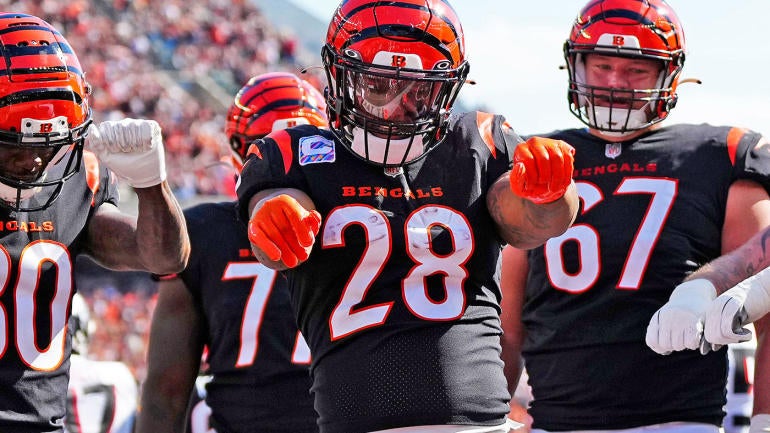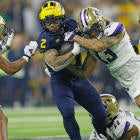
For all the success the Texans had last year, the one area they struggled with over and over again was the running game. By pretty much every single rushing metric they lagged. Even second-level data like rushing Expected Points Added, yards before contact per rush and negative rush rate were inside the bottom 10 of the league, and their running backs collectively scored seven touchdowns including a weak 23.8% success rate inside the 5-yard line (five scores on 21 attempts).
Joe Mixon will be in his age-28 season and is coming off a pretty good year with the Bengals -- 1,410 total yards on 309 touches (52 catches). He finished top-12 among running backs in all of the aforementioned stats the Texans struggled with, including a 33.3% success rate inside the 5-yard line (seven scores on 21 attempts). Mixon has a 37.7% success rate inside the 5 over his past three years.
His experienced, versatile and (somewhat) explosive skill set is what the Texans need to boost their run game and make it a strength in 2024. That's why they traded for him when he became available after Cincinnati signed Zack Moss at the start of free agency.
Ask any Fantasy manager who rostered Mixon last year and they'll tell you about how up-and-down he was. A slow start (11.5 PPR points per game in his first six) gave way to a fiery finish (18.0 PPR points per game in his last 11). Keep in mind that a lot of those last 11 games came without Joe Burrow under center, so he thrived even with an inferior quarterback ... not that he'll have one of those in Houston.
It's not like Mixon was suddenly a better player after the bye. His rushing average perked up from 3.8 to 4.1 yards per carry and his explosive play rate (carries of 12-plus yards) went from a terrible 6.3% to a solid 8.7%. He caught 3.3 passes per game after the bye compared to 2.7 before the bye. Everything else about him stayed the same except for one thing: Touchdown opportunities. He scored one through his first six games and 11 in his last 11 (43.8% success rate inside the 5). That salvaged his Fantasy season, not to mention kept the Bengals in a bunch of games.
So can Mixon keep scoring with the Texans? Will he still have a promising amount of touches? Is the offense a good fit?
The answers to all three questions are yes but with asterisks.
As their roster stands right now, Mixon should be the unquestioned goal-line back. Dameon Pierce wasn't good at it during his rookie year (3 TDs on nine rushes) and was worse in his second season (2 TDs on nine rushes). No one else profiles for the role.
Beyond goal-line carries, Mixon figures to be no worse than Devin Singletary was in terms of rushing. That's because the two profiled similarly as rushers last year, both close to each other in pretty much every single rushing metric. The differentiator between the two was the ability to score from short range.
| player | PPR/gm | G | Rsh/G | Yd/Rsh | RshTD | inside 5% | %Rs0Neg | %Rs5+ | Expl % | Avoid% |
| Devin Singletary | 9.84 | 17 | 12.7 | 4.2 | 4 | 22.2% | 16.2% | 33.8% | 7.9% | 13.9% |
| Joe Mixon | 15.71 | 17 | 15.1 | 4.0 | 9 | 33.3% | 16.0% | 31.9% | 7.8% | 12.1% |
Once Singletary was the unquestioned lead back in Houston last season (Weeks 9 through 18) he averaged 16.7 carries and 2.3 receptions per game. A similar workload may await Mixon in 2024.
That brings up an important side note: Another major difference between Mixon and Singletary was their pass-game production, Frankly, Mixon has been better than Singletary for years. Over their past four seasons, Mixon has bested Singletary in every single receiving number imaginable with a surprising discrepancy in explosive pass play rate: 7% for Mixon, 4.7% for Singletary.
As for the scheme fit, it figures to be an easy digest for Mixon considering that Bengals coach and playcaller Zac Taylor is from the same coaching tree and has similar coaching principles as Texans play-caller Bobby Slowik.
But therein lies the first of a handful of asterisks.
Slowik's Texans ran more zone-scheme runs than power-gap runs. Since 2022, Mixon has excelled at power-gap runs. Offensive line play is a huge factor here and the Texans may have just felt like they were better off using zone because they didn't have the physicality or athleticism to match up with a power gap scheme. The more bulk Houston adds, the better it will theoretically be for Mixon.
Slowik's Texans also used multiple players in their rushing attack. Singletary didn't play on a lot of third downs last season and wasn't a big-time factor anytime the Texans were trailing in the second half. Mixon himself was in a similar spot, off the field on third downs for much of 2023. As great as it is to say Mixon will take over Singletary's role, it could mean he's still not a third-down player.
Furthermore, it would make plenty of sense for the Texans to make that second running back a rookie who could become a starter as soon as 2025 when Mixon's contract expires. If Houston uses a pick on someone like Jonathon Brooks or Jaylen Wright -- guys who excelled in zone-based run schemes in college -- Mixon could lose more touches than initially believed.
And if that happens then everything from Mixon's workload to his touchdown production is thrown into question.
So for now, Mixon stands out as a potential 1,400-total-yard, eight-touchdown running back nestled into one of the league's ascending offenses. That's not just good, that's close to top-15-at-the-position good. If he manages to go the rest of the offseason without serious competition added, he'll get taken in Round 4 at the latest. If competition arrives then he could fall as far as 60th overall, right on the border between Rounds 5 and 6. If you're drafting before May, Mixon in late Round 5 is fine. And if you're in Dynasty, Mixon belongs on a win-now roster because there are no guarantees after this year.





















